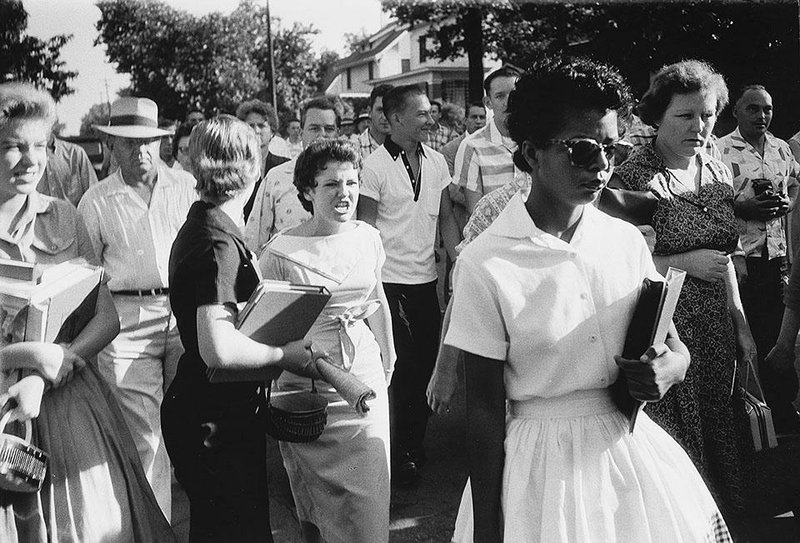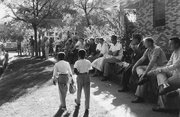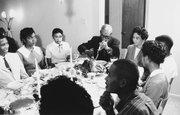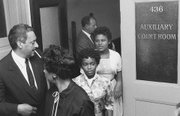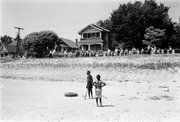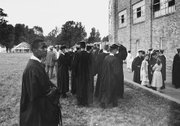The passing of six decades has muted the suffering and shame of Little Rock's school desegregation crisis, by now a distant hum of history.
One of the nine brave black students who desegregated Central High School in 1957 is no longer alive. The other eight are senior citizens in their mid to late 70s. Most all the adult antagonists in the turmoil that continued through 1959 -- integration activist Daisy Bates, Gov. Orval Faubus and a host of others, courageous and craven -- have been dead for years.
But such a stretch of time also can open new perspectives on Little Rock's long-ago trauma, whose details are known vaguely or not at all to a great many Arkansans today. Offering a fresh look is a main aim of Arkansas Arts Center's riveting new exhibition, "Will Counts: The Central High School Photographs."
Displayed through Oct. 22, Counts' 38 images illuminate a defining episode in the twilight of legally mandated Jim Crow segregation -- a cultural warp that twisted the minds and lives of white and black Southerners for almost a century. Some of the photographs are painful to view, maybe even hard to believe in 2017, given the raw racial hatred they depict.
The black-and-white photos, some shown previously at the Arts Center, were taken for the Arkansas Democrat by a slender 26-year-old native of the state. He was able to move among the angry white crowds in part because he looked as young as a high school student. He wielded a 35-mm camera that could shoot much more rapidly than the bulkier old models used by other Democrat and Arkansas Gazette photographers.
Counts' most famous image, part of this exhibit, shows a gaggle of protesters trailing black student Elizabeth Eckford. The angry
tormentors include a white teenager with her mouth open to yell and her face set in hate. The picture, reprinted around the world, was eventually named by The Associated Press as one of the 20th century's top 100 photographs.
Later a journalism professor at Indiana University, Counts donated the gelatin silver prints in this exhibit to the Arts Center in 1997, four years before his death at age 70. They are arranged in chronological order in the museum's Sam Strauss Sr. Gallery, along with an interactive digital timeline that traces key events in race relations and Central High history from the school's opening in 1927 to the present.
"These Will Counts images remain important and relevant as documents of events," says Ann Wagner, the exhibit's curator, who worked with designer Keith Melton. "They also remain powerful as works of art. They are strong images -- often frightening ones. We need to spend time with them and really look hard to see what we can learn. Each viewer will find things that others may not see."
FOCUSES OF THE PHOTOS
Eight of the 38 photos show Eckford's failed effort to enter the high school on Sept. 4, 1957, when she showed up alone due to failed communications rather than joining the other eight black students who arrived as a group.
Five images picture her being turned away from Central's entrance by Arkansas National Guardsmen. Then come two photos, including the famous one, of her being taunted. Finally, she is seen seated at a bus stop, in the dress she had made for the special occasion, wearing dark glasses and clutching a notebook. New York Times reporter Benjamin Fine, wearing a bow tie, is seen in the crowd behind her. "Don't let them see you cry," he urged her. She didn't.
Another seven photos, the most shocking in the exhibit, were taken by Counts on Sept. 23, when what the Arkansas Democrat called "uncontrolled violence" erupted after the nine black students had entered Central by a side door.
A half-dozen white men in one of the mobs attacked Alex Wilson, a black journalist from Memphis. He was jeered, grabbed, tackled around the neck, thrown to the ground and kicked in the chest. Along with the photographs, Counts wrote a bylined front-page story about the incident. His pictures of the beating are said to have been a prime factor in President Dwight Eisenhower's decision to send 101st Airborne Division troops to enforce the desegregation.
In endearing contrast to those brutal scenes are two photos taken that Thanksgiving Day at the home of Daisy Bates and her husband, L.C. Bates. In one image, they are seated at the dinner table with the Little Rock Nine and a white minister, heads bowed in prayer. In the second, L.C. Bates is carving the turkey.
Other photos portray an assortment of events that Counts covered. The latest are from Aug. 12, 1959, when Little Rock's high schools reopened after having been closed for a year to stave off integration. Those shots show about 250 segregationist protesters marching toward Central and trying to break through police lines as 21 arrests are made.
A FAVORITE IMAGE
Asked which of Counts' 38 images speaks most eloquently to her, Wagner makes what may seem a surprising choice: "the photograph of two African-American grade-school students walking past a line of white adult protesters sitting on a low wall.
"The little boys are dressed up for school in clean white shirts and one carries a lunch bag," she observes. "The sun shines on their hair, giving them what looks like glowing halos. You can't see their expressions, but you can bet they are scared to walk past all those angry adults. But still, they have to go to their segregated school, so they do what they have to do."
To Wagner's eye, "Counts shows us the scene from the boys' point of view. Some of the white men stare past the boys, but an older man and several women look toward the two with almost friendly expressions, or even smiles.
"The photograph lets us see each protester as an individual, so we can try to understand how each one feels and thinks. They're protesting, so we must suppose they don't want the black boys to be there. But as we see the individual adult faces, we may start to wonder if -- faced with actual little boys -- some of the protesters might be thinking of changing their minds."
That hopeful outlook is reflected in Wagner's perspective on the 1958 vote, engineered by Faubus, that led to the city's high schools being closed for a year to ward off desegregation.
"It's clear that a great many people were trying to bring people together in Little Rock," she says. "Those peacemakers were here -- the Little Rock citizens of whatever race or background who believed in equal rights for all Americans.
"When the vote was held in 1958, it's true that there were 19,470 votes to close high schools rather than continue the segregation that they had always known. But there were 7,561 votes for integration of the schools, and that's a lot of brave people willing to make a big change. We haven't paid enough attention to those people."
Jack Schnedler, retired deputy managing editor/features of the Democrat-Gazette, wrote a profile of Will Counts for the newspaper in 1997. He is training to be a docent at the Arkansas Arts Center.
Style on 08/20/2017
